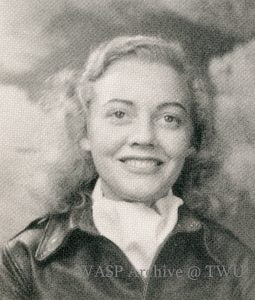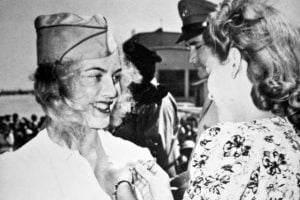 Betty C. Tackaberry Blake
Betty C. Tackaberry Blake
October 29, 1920 – April 9, 2015
Class: 43-W-1
Training Location: Houston Municipal Airport (Tex.)
Assigned Bases: Long Beach Army Air Base (Calif.)
Planes flown: B-17, B-24, B-26, C-21, Cessna 170, DC-3, P-38, P-39, P-40, P-51, P-63, X-47
Graduation Details
Dates: November 15, 1942-April 24, 1943
Number of Trainees: 29 trainees, 23 graduates
Place: Ellington Field, Houston, Texas
Graduation Speaker: Major General Gerald C. Brant, Commanding General AAF Gult Coast Training Center
Distinguished Guests:
Jacqueline Cochran, Director of Women’s Flying Training Command
Admiral L.O. Colbert, U.S. Coast and Geodetic Survey (daughter was member of graduating class)
Colonel Walter H. Reed, Commanding Office, Ellington Field
Band: Ellington Field AAF Band
Born in Hawaii while it was still a territory, Betty spent her early years reading books about aviation. Blake, who began flying at the age of 14 in 1934, became even more interested in airplanes when she met Amelia Earhart at the University of Hawaii in January 1935. Earhart traveled to the islands on her quest to become the first pilot to solo the 2,408 miles across the Pacific Ocean between Honolulu and Oakland, California. Blake was the only child in the audience, so she was seated in the front row for Earhart’s speech. Afterward, Earhart sat beside Blake and invited her to the airport to see the twin-engine Beechcraft she would be flying the following day.
Betty had her first flight at age 15, then hitchhiked to the airport and did bookkeeping for flying lessons. She attended University of Hawaii, was accepted into the college’s Civilian Pilot Training program and earned her license. She then flew tourists around the Islands. On Saturday, Dec. 6, 1941, she had passed tests for commercial license and instructor rating and was scheduled to fly a tourist around the island at 6:30 am. He canceled that afternoon. On December 7, 1941, Betty was at home with Ensign Robert Tackaberry, a young sailor from the USS California, when Pearl Harbor was attacked. Fortunately, Ensign Tackaberry was at the Guild home and not on the ship at the time. Betty and “Tack” did see the attack, however, from her home above Honolulu. She felt lucky that she had cancelled an island tour for Sunday or she might have been the “first casualty” on December 7th. Betty’s father helped get Tack back to his ship, though they had to hide in the Pearl Harbor gatehouse until the second raid ended. Later Betty was secretly married to this lucky young ensign by the man who wrote “Praise the Lord and Pass the Ammunition,” a popular wartime song. When her husband returned to duty, Betty continued her dream of flying.
In 1942, the Women’s Air Ferrying Service, or WAFS, started accepting application for female pilots in Delaware. Black quickly went down from Philadelphia to sign up. However, she was turned down

Blake receiving her wings from Jacqueline Cochran
because she was short fifty hours of the required flying time. Shortly afterwards, she received a letter from Jackie Cochran, appointed by General. “Hap” Arnold, the director of the Women’s Flying Training Detachment (WFTD) to be in the first class. Only two hundred hours were needed for the class. The 23-week training program began in Houston, Texas, at Howard Hughes Field. Later, classes moved to Sweetwater, Texas. There were 32 women in her class. They were dubbed. “Guinea pigs” because they were the first class of that kind. Blake graduated on April 24, 1943, at Ellington Field, Houston, in the first WFTD class 43-W-l of 23 women.
Blake chose to be stationed in Long Beach, California, near most of the major airplane factories, ferrying planes. She was one of the first five gals along with 2,000 male pilots. She remembered that “A lot of them were married and their wives were back east having babies and things. So there were lots of lonely men out there. About the third night they had put up a 24-hour guard around our officers barracks because they were climbing through the windows.”
They often flew seven days a week, ferrying planes fresh off the factory assembly line to selected military bases across the country. The women flew anything from P-51 Mustangs, a single seated fighter plane, to twin-engine C-47 transports and four-engine B-17s and B-29s. It was imperative for the pilots to break in a new plane’s engine, flying it at different RPMs and miles per hour. They followed commercial airline routes, calling in to radio stations every 50 miles along the route to check in. Groups of pilots always stayed in touch by meeting at the Red Cross canteens or the local coffee shop to talk about flying – “hangar flying,” they called it.
Most men were hesitant to think that women could handle the planes. One day, Blake was co-piloting a DC-3 (C-47) with another WASP (Women Airforce Service Pilots) to Fort Wayne, Indiana. Blake and her co-pilot drove over to the plane they were going to ferry. Standing there was a big, husky sergeant – in disbelief when two girls got out of the jeep to fly his plane.
“On takeoff he stood between our seats and I looked at him after we got into the air and he’s just perspiring. His face is red and he’s got perspiration running off. Poor man was scared to death. Well, we got to El Paso, which was our first fuel stop, and I stayed in the plane. And he said he’d go out and tell the ground crew to gas up. We could hear them razzing him about flying with two women pilots. I made a perfect landing in El Paso. I used to make wheel landings instead of the three-point landings. It’s a lot easier to land. So I made a wheel landing and I just greased it on that day. I was really working on it, too. And I heard him say, ‘That’s the best god-damned landing I’ve ever had in that airplane.’ Boy, was I proud when I heard him say that.”
One particular time, Blake was very concerned about not making it to her destination when flying a P-39 from Niagara Falls to Montana. She was about fifteen minutes east of Rochester when smoke started coming out of the engine.
“I’m 16,000 feet in the air. I am looking down at beautiful grass, just pasture sort of land below me. And I’m thinking I better out of this plane. I better bail. I didn’t want to bail out; I really never wanted to bail. Never had to. I looked back – in this plane the engine is behind the cockpit – and thought, maybe there isn’t as much smoke as I thought there was. I’ll wait another second. I literally went through the whole procedure, the whole practice procedure and everything. Checked all the straps on my parachute and waited another second, looked back and thought there was a little less smoke. So I thought I’d wait another second and I’m getting closer to Rochester where I could land. It wasn’t a scheduled stop but I knew they had a field there. I was really shaking.”
Blake finally landed, collapsing to her knees as she got out of the plane. She recalls, “They pulled the side off the engine and it was absolutely black. It had an oil leak, but they said it could have caught fire and just blown up with all that 100-octane gas in it. I knew it was back there; as everybody says, you should have bailed out.”
After two successful years flying as a WASP, Blake was deactivated in 1944. Afterwards, she did many interesting jobs, including being a link trainer (simulator) and piloting planes for SNAFU Airlines.
She also flew shrimp from New Orleans to Los Angeles – smelly. She soon remarried and moved to Arizona with her second husband, George Blake, a Pan Am pilot who had also been in the Air Force; together they raised three sons. All of them are pilots.
Blake and the other WASP have forever changed what was possible for women across the world. General Arnold once said, “You WASP… have shown that you can fly wingtip to wingtip with your brothers. The entire operation has been a success. It is on record that women can fly as well as men. I salute all WASP! We of the AAF (American Armed Forces) are proud of you; we will never forget our debt to you.”
Betty was the last surviving member of the first training Class 43-W-1 at Sweetwater, Texas, on April 24, 1943)
Sources:
Courtesy Texas Women’s University in Denton, Texas
Military.com
The Peak
Wikipedia
Wings Across America





